No sambar powder for making kuzhambu? No worries. Here is my lip-smacking poondu kuzhambu or the South Indian style garlic stew/gravy made without sambar powder. A perfect gravy to relish along with hot steamed rice.
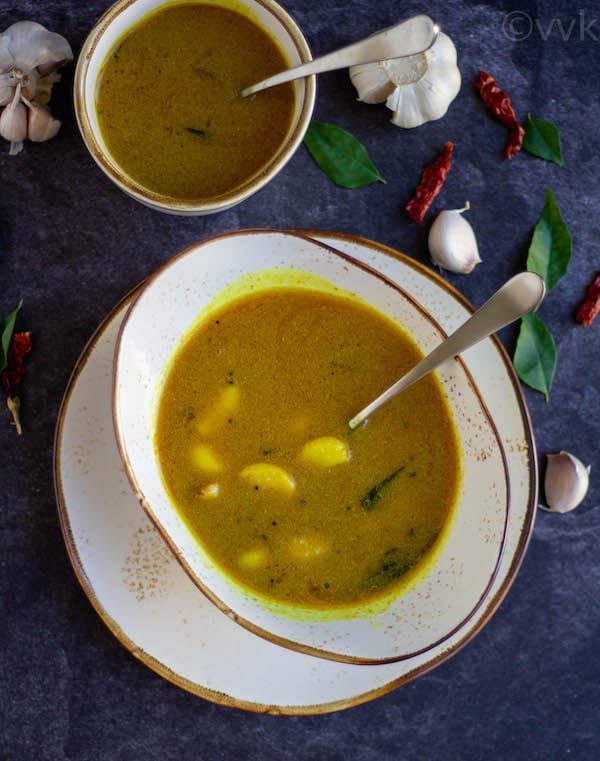
Poondu means garlic in Tamil, and Kuzhambu means tamarind based tangy stew/gravy in Tamil. I have shared quite a few kuzhambu varieties before, but today’s recipe is something special. I made this garlic kuzhambu without any sambar powder. Before getting into the details, let me talk about kuzhambu.
Kuzhambu is an integral part of the Tamil Nadu cuisine. When you explore Tamil food, you will realize that this kuzhambu be it veggie based one or meat or seafood-based, is a part of everyday cooking.
Like sambar, you will find kuzhambu varieties ruling the kitchens of Tamil Nadu. I will explain the difference between sambar and kuzhambu in a different post. Now let’s get back to our kuzhambu business.
There are zillion varieties of kuzhambu, and every household has its authentic version of kuzhambu along with the sambar powder or spice mix that they use for the kuzhambu.
In our home, we don’t use any unique kuzhambu spice mix. We use the same sambar powder for sambar and also kuzhambu. Trust me, folks, and this sambar powder makes all the difference. I have always used homemade sambar powder, so I cannot vouch for the store-bought ones.
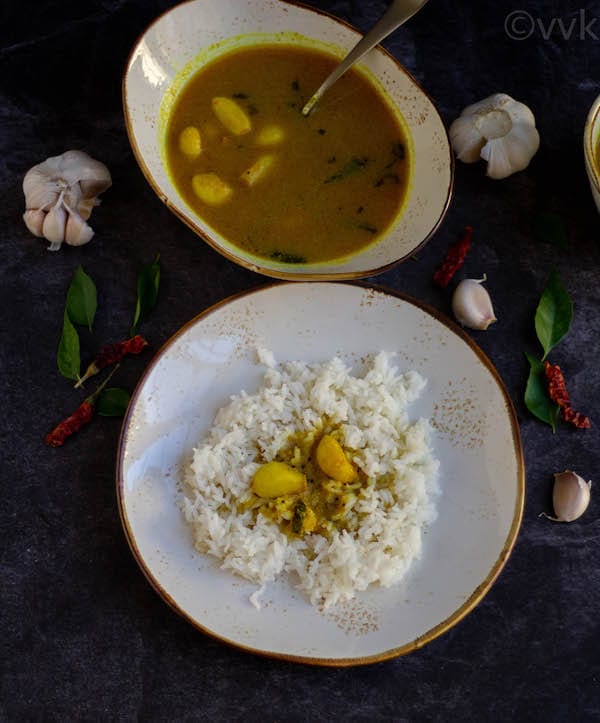
Recently, I received quite a few requests for posting a kuzhambu without sambar podi and also making a small batch of sambar powder/spice mix. I have the traditional sambar powder recipe where the ingredients are sun-dried and ground in the flour mill. I will soon post the NRI version of sambar powder.
Now here is the kuzhambu recipe without sambar powder.
Spice Mix that I Used:
The two main ingredients used in sambar powder are coriander seeds and dried red chilies. We do add other ingredients, but they are more like aromatics, and you can adjust them depending upon the availability.
With that in mind, I used store-bought coriander powder and red chili powder for this kuzhambu recipe. I ground these two spice powders with dried red chilies and coconut.
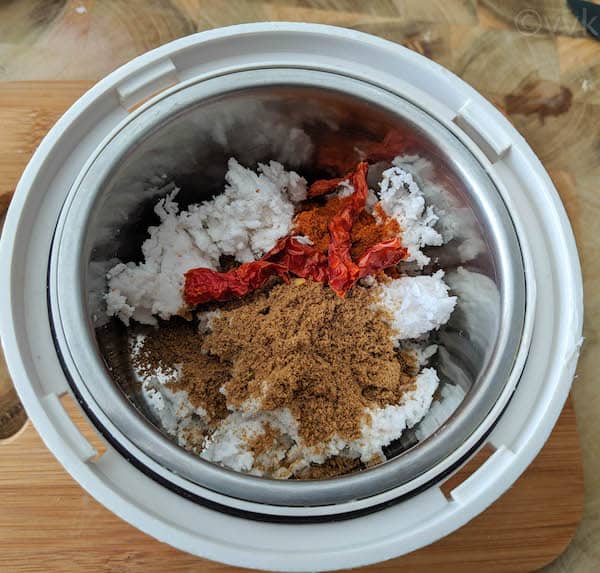
Why coconut? IMO, coconut and coconut oil make all the dishes delectable. It’s optional, but please do give it a try with coconut. :-)
More details are in the recipe notes. Please don’t miss it.
How to Serve this Kuzhambu-
While you can serve kuzhambu as a side for idli or dosai, I personally love it with rice. You can see how I served it with rice along with kootu and raita on this Instagram post of mine. You mix the kuzhambu with rice and relish it along with the veggie side.
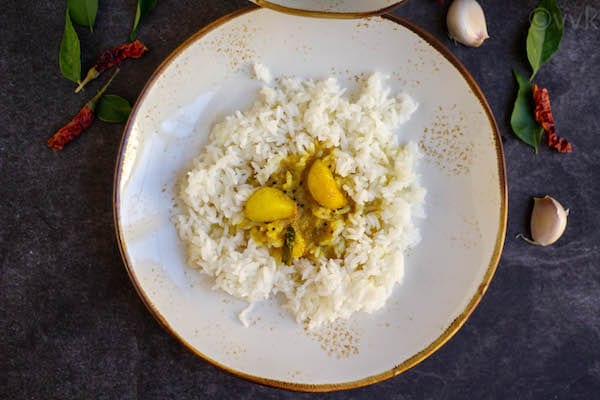
If you notice, the kuzhambu is vegan. I did not make it vegan on purpose, but by nature, it is vegan. Skip the asafoetida or use gluten-free asafoetida to make it gluten-free. That’s the beauty of South Indian cuisine. Most of the recipes are vegan and gluten-free. You can explore a lot of vegan and gluten-free recipes on my blog.
Now without any further ado, here is the garlic kuzhambu recipe with sambar powder. Please do try this recipe and let me know your thoughts and feedback.
Poondu Kuzhambu without Sambar Powder-
Prep-Work:
- Peel the garlic cloves. We need 25 to 30 cloves, and peeling is a time-consuming task. As I mentioned in my gifts under $10 post, I used my silicone trivet for peeling it.
- Also, grind the coriander powder, red chili powder, dried red chilies, and coconut by adding ½ cup of water into a smooth paste in a blender or mixer jar.
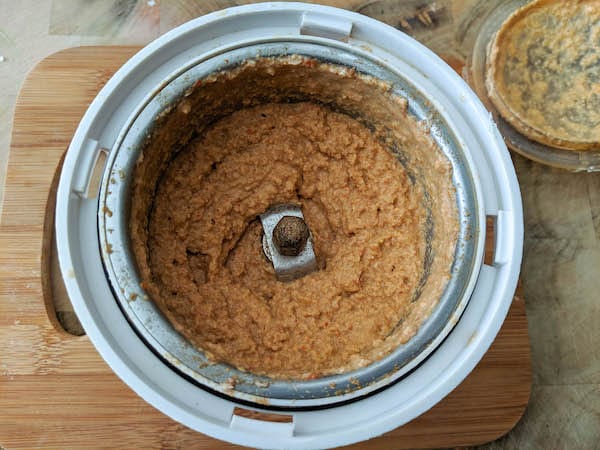
- Mix 2 tsps of tamarind paste in 1 cup of water and set it aside.
Poondu Kuzhambu Recipe With Step-Wise Pictures:
- Heat a pan and add the sesame oil. When the oil is hot, add the mustard seeds, fenugreek seeds, asafoetida, and curry leaves.
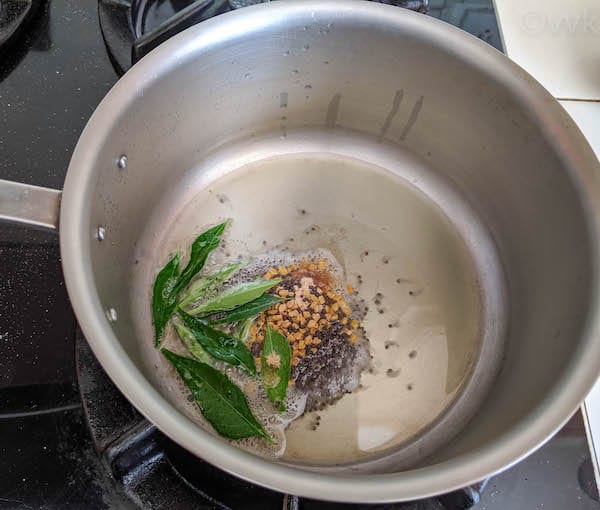
- Let the mustard seeds sputter. The oil will become frothy, and that’s normal if you are using sesame oil.
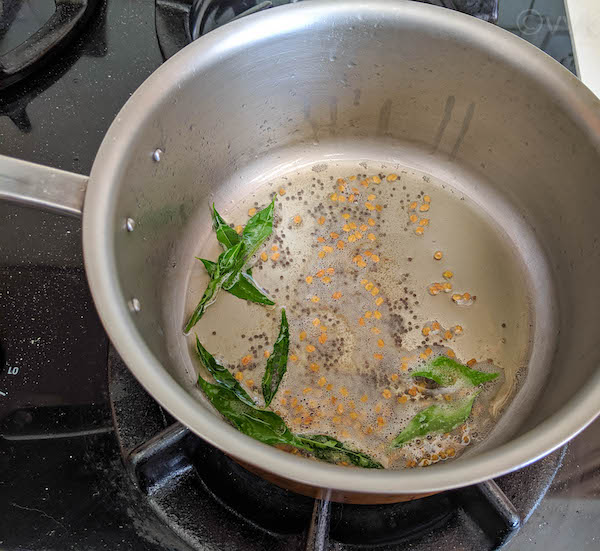
- Now add the garlic and the turmeric powder.
- Mix well and cook for 3 to 4 minutes over medium-low heat or until the garlic turns light brown.
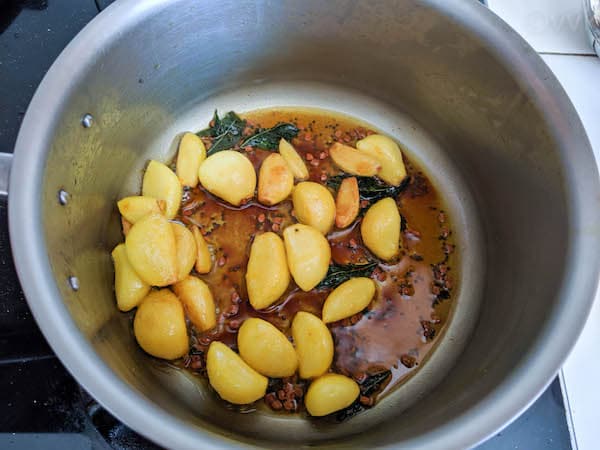
- Then add the tamarind water (tamarind paste mixed with water) and salt.
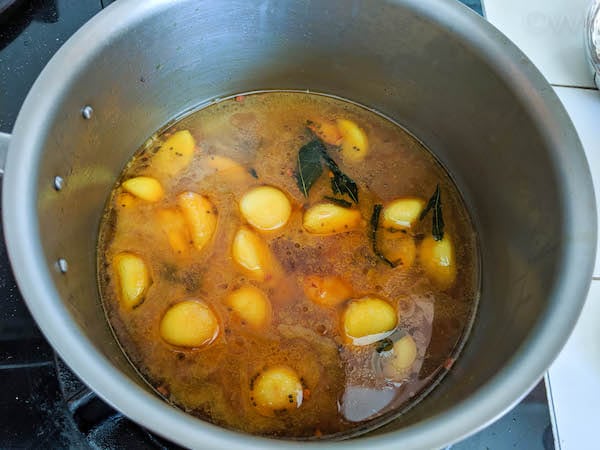
- Simmer it for 5 minutes or until the raw smell of the tamarind goes off.
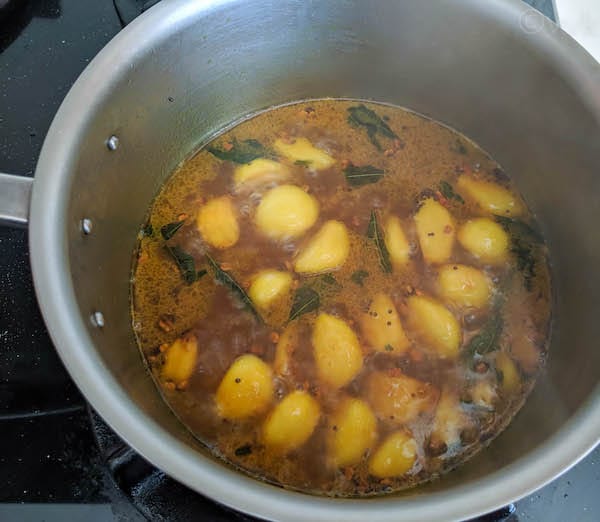
- At this stage, add the ground paste and jaggery. Rinse the mixer jar with 1 cup of water and add it as well. Mix well.
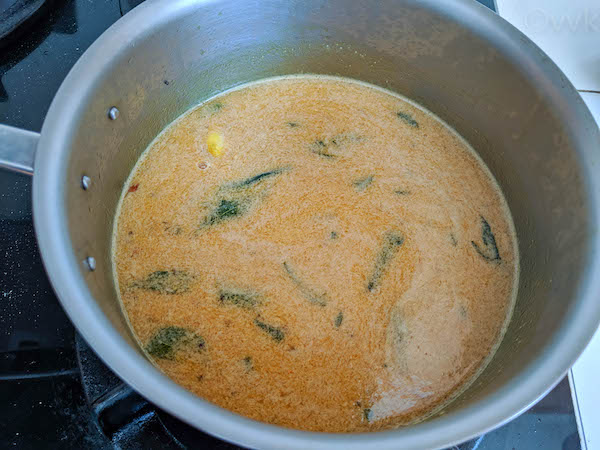
- Reduce the heat to medium-low and simmer it for 10 to 12 minutes.
- Now check the consistency of the kuzhambu. If you prefer thin consistency, then simmer the kuzhambu for three more minutes and turn off the heat.
- If you prefer slightly thick consistency, mix ½ tsp of rice flour with 2 tbsp of water and make a slurry.
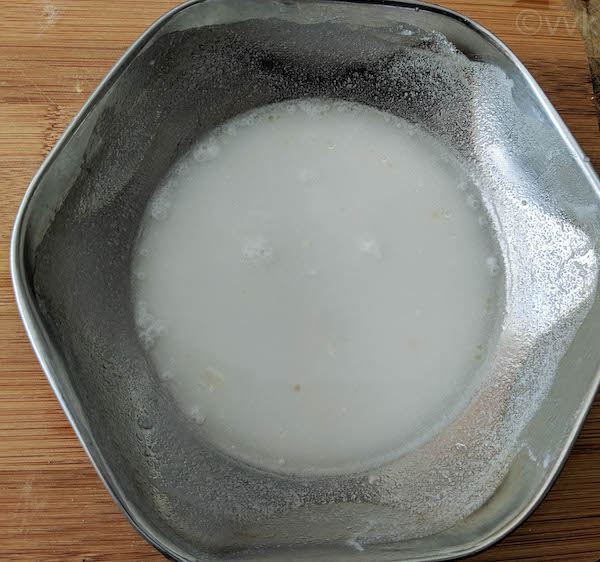
- Now add this slurry to the kuzhambu and simmer again for 5 minutes.
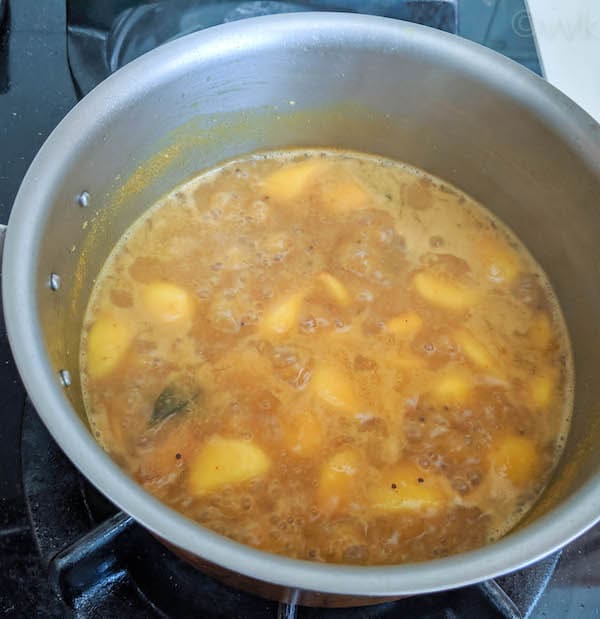
- That’s it. Poondu kuzhambu is ready. Serve hot with rice.
Recipe Notes:
- I did not add any onions or shallots or other vegetables. I wanted to bring out the garlic flavor exclusively. But you can add ½ cup of chopped onion or five shallots and also ½ of vegetables like drumstick, brinjal or okra.
- The garlic clove size varies. So depending upon that, adjust the amount. If you have small cloves, you can add up to 30 to 35 cloves.
While tempering, you can also add 1 tsp of toor or split pigeon peas. It adds a sweet flavor. - Spice & Salt: Always adjust the salt and seasonings according to your taste. I add two dried red chilies and ½ tsp of red chili powder. But you can increase this measure to 3 or 4 dried red chilies depending upon the variety and 1 tsp of red chili powder. For a bring fiery red gravy, try Kashmiri red chili powder, or Kashmiri dried red chili variety. I used regular red chili powder and Byadgi variety of chilies for this recipe.
- Tamarind: I used homemade tamarind paste. As I mentioned in vathal kuzhambu post, adjust the tamarind depending upon the variety. The age of the tamarind plays a significant role.
- Instead of tamarind paste, you can use tamarind pods. In that case, soak a small gooseberry sized tamarind in 1 cup of water for at least 30 minutes and extract the juice.
- You can skip the fresh ground masala and 1.5 tbsp of sambar powder. It will be more like poondu puli kuzhambu/vathal kuzhambu.
- Simmer in medium-low heat for a long time helps to intensify the flavor. Also, as the kuzhambu cools down, it thickens slightly.
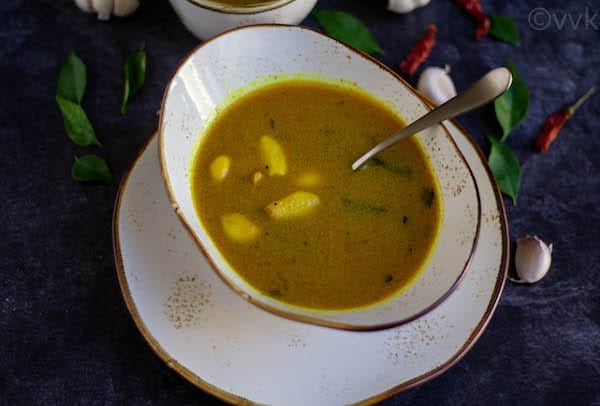
Other Kuzhambu Recipes:
If you like this kuzhambu recipe, then don’t forget to check out my other kuzhambu varieties like,
- Dhaniya Kuzhambu
- Vathal Kuzhambu
- Spinach Buttermilk Sambar
- Brinjal and Black-Eyed Peas Kuzhambu
- Cranberry Sauce Vathal Kuzhambu
- Instant Mor Kuzhambu | Raw Buttermilk Sambar
PS: Follow me on Instagram or join my Facebook Group for more gardening and recipe updates. If you try this poondu kuzhambu recipe, please don’t forget to comment and rate this recipe. If you have any questions, please leave a comment, and I will get to it asap. Make sure to follow me on my Pinterest for more healthy and delicious ideas!
📖 Recipe
Poondu Kuzhambu | South Indian Style Garlic Stew / Gravy
Ingredients
- 2 tbsp sesame oil or gingelly oil
- 1 tsp mustard seeds
- 1 tsp fenugreek seeds
- ¼ tsp asafoetida
- 10 curry leaves one sprig/strand
- 2 tsp tamarind paste
- ½ tsp turmeric powder
- 25 garlic cloves peeled
- 2 tsp salt or to taste
- 1 tsp jaggery powdered
- 2.25 cups of water divided 1 cup for tamarind paste, 1 cup extra, 2 tbsps for rice flour slurry
- ½ tsp rice flour optional
To Grind:
- 2 tsp coriander powder
- ½ tsp red chili powder or to taste
- 2 red chilies dried
- ¼ cup grated coconut
- ½ cup water
Instructions
- Peel the garlic cloves. We need 25 to 30 cloves, and peeling is a time-consuming task. As I mentioned in my gifts under $10 post, I used my silicone trivet for peeling it.
- Also, grind the coriander powder, red chili powder, dried red chilies, and coconut by adding ½ cup of water into a smooth paste.
- Mix 2 tsps of tamarind paste in 1 cup of water and set it aside.
- Heat a pan and add the sesame oil. When the oil is hot, add the mustard seeds, fenugreek seeds, asafoetida, and curry leaves.
- Let the mustard seeds sputter. The oil will become frothy, and that's normal if you are using sesame oil.
- Now add the garlic and the turmeric powder.
- Mix well and cook for 3 to 4 minutes over medium-low heat or until the garlic turns light brown.
- Then add the tamarind water (tamarind paste mixed with water) and salt. Simmer it for 5 minutes or until the raw smell of the tamarind goes off.
- At this stage, add the ground paste and jaggery. Rinse the mixer jar with 1 cup of water and add it as well. Mix well.
- Reduce the heat to medium-low and simmer it for 10 to 12 minutes.
- Now check the consistency of the kuzhambu. If you prefer thin consistency, then simmer the kuzhambu for three more minutes and turn off the heat.
- If you prefer slightly thick consistency, mix ½ tsp of rice flour with 2 tbsp of water and make a slurry.
- Now add this slurry to the kuzhambu and simmer again for 5 minutes.
- That's it. Poondu kuzhambu is ready. Serve hot with rice.
Notes
- I did not add any onions or shallots or other vegetables. I wanted to bring out the garlic flavor exclusively. But you can add ½ cup of chopped onion or five shallots and also ½ of vegetables like drumstick, brinjal or okra.
- The garlic clove size varies. So depending upon that, adjust the amount. If you have small cloves, you can add up to 30 to 35 cloves.
- While tempering, you can also add 1 tsp of toor or split pigeon peas. It adds a sweet flavor.
- I highly recommend sesame oil or gingelly oil for this recipe but if you can't source it you can use other oil as well.
- Spice & Salt: Always adjust the salt and seasonings according to your taste. I add two dried red chilies and ½ tsp of red chili powder. But you can increase this measure to 3 or 4 dried red chilies depending upon the variety and 1 tsp of red chili powder. For a bring fiery red gravy, try Kashmiri red chili powder, or Kashmiri dried red chili variety. I used regular red chili powder and Byadgi variety of chilies for this recipe.
- Tamarind: I used homemade tamarind paste. As I mentioned in vathal kuzhambu post, adjust the tamarind depending upon the variety. The age of the tamarind plays a significant role. Instead of tamarind paste, you can use tamarind pods. In that case, soak a small gooseberry sized tamarind in 1 cup of water for at least 30 minutes and extract the juice.
- You can skip the fresh ground masala and 1.5 tbsp of sambar powder. It will be more like poondu puli kuzhambu/vathal kuzhambu.
- Simmer in medium-low heat for a long time helps to intensify the flavor. Also, as the kuzhambu cools down, it thickens slightly.
Nutrition
I am not a nutritionist. The nutritional information is provided as a courtesy and is an estimate only. It varies depending upon the product types or brands.
Update Notes: Earlier posted this recipe in 2014. I have updated the recipe with new pictures.



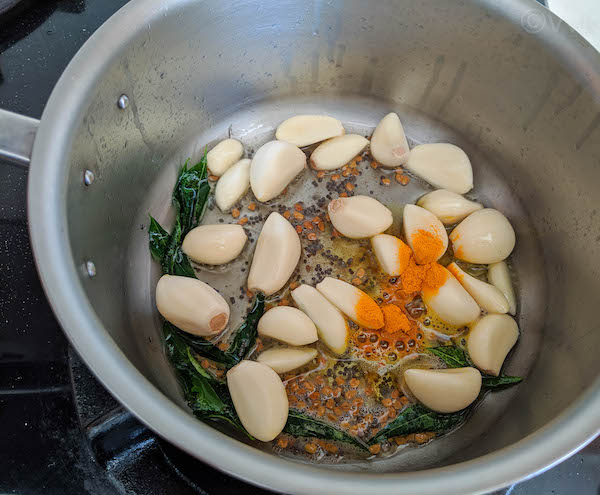
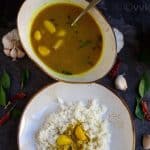

good recipe
Prepared this recipe for first time and every one appreciated. Added carrots, beans, onions
Thanks a lot. Glad everyone liked it. Thanks for the feedback.
Prepared this recipe for first time and every one appreciated.
One of my fav kuzhambu:) never I prepare something heavy next day I opt for this as it helps for digestion
Very true